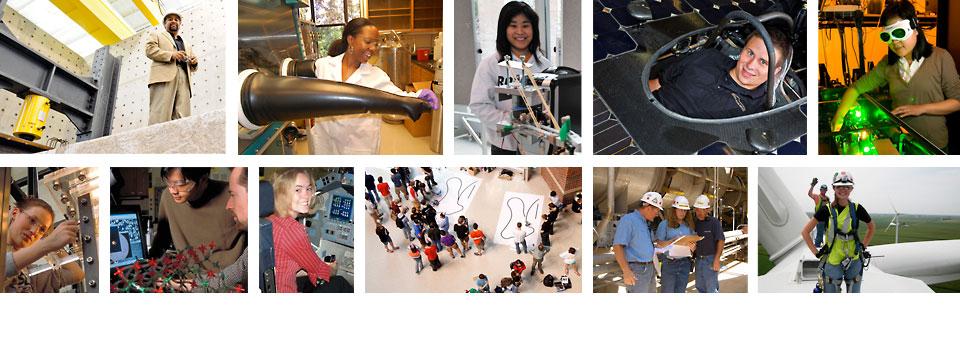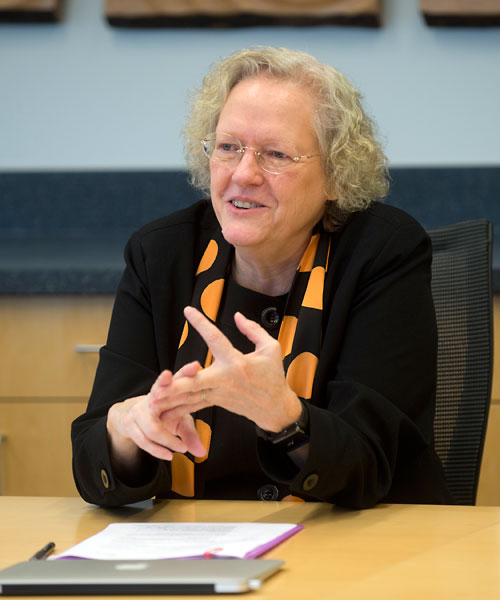Bold initiative builds on innovation and growth
Bold initiative builds on innovation and growth
| Author: | Amanda Hamon |
|---|---|
| Magazine Section: | Our People, Our Culture |
| College or School: | CoE |
| Article Type: | Issue Feature |
| Page CSS: | #jamieson {
float: left; width: 300px; margin: 1em 1.5em 1em -210px; } .event-image img { max-width: 100%; } |
| Feature Intro: | Purdue University is embarking on a program to add as many as 107 College of Engineering faculty over the next five years — an increase of 30 percent. |
The additional faculty will allow the college to grow enrollment and expand the breadth and depth of its research efforts.
"This move will provide an economic benefit to the country as we educate more engineers with the Purdue credentials that are highly valued by industry, government and academia," says acting President Timothy Sands.
"The U.S. Council on Jobs and Competitiveness has called for an additional 10,000 engineers a year. We're stepping up to this challenge. We want to add to our pool of highly qualified students, especially Hoosiers, at a time when the nation is demanding more engineers," says Sands, an engineer himself, who contributed to the development of LED lighting.
During the initiative, the college will look to hire up to an additional 107 faculty members — junior and senior faculty as well as renowned experts — which will increase the college's number of faculty by 30 percent. With the additional faculty, undergraduate enrollment will grow by almost 10 percent to more than 7,750 and graduate enrollment will grow by 750 to 3,500. It also will look to hire 105 additional staff members -— ranging from support staff to development professionals to information technology specialists — to support the growth in faculty and students.
Leah Jamieson, the John A. Edwardson Dean of Engineering, says the initiative is in line with the growth the college has experienced in the previous five years. During that time, undergraduate enrollment has increased by 17 percent, graduate enrollment has increased by 28 percent and annual research expenditures have increased by 79 percent.
“Growing engineering contributes to the economic development of the state and the nation. Engineering jobs pay well, and unemployment in engineering is lower than the average for other disciplines,” Jamieson says. “And engineering will play a crucial role in addressing global grand challenges ranging from energy and the environment to security and health care.”
Jeff Immelt, chairman and CEO of GE, says there is a need for more engineers.
"A critical sustainable competitive advantage for a company or a country is its technology base, and I applaud Purdue University and its leadership's commitment to educating more world-class engineers," he says.
When hiring faculty, the college will focus on its most pressing needs first. Those hiring efforts will immediately improve student-to-faculty ratios, a result that will allow engineering students to experience deeper learning in more collaborative environments.
Some efforts to hire faculty will involve the Office of the Provost’s cluster hiring program, which involves targeted hiring across colleges to support interdisciplinary fields. Faculty hiring efforts related to interdisciplinary majors also will include other colleges, Jamieson says. For example, the initiative includes hiring at least six new faculty members for the integrated imaging program, which involves chemistry, the biosciences, electrical and computer engineering, and biomedical engineering.
Faculty members hired through the initiative will bring additional research opportunities, which will create cross-campus collaborations that will be vital for Purdue’s future.
The initiative will be funded through a combination of funds from the Office of the Provost, the college’s differential fees, reallocation of funds within engineering and a five-year $135 million fundraising effort specifically focused on strategic growth, Jamieson says.
One goal during hiring will be to increase the diversity of the college’s faculty and staff, Jamieson says. The college will seek diverse faculty to create a more welcoming environment for students of all genders, races and ethnicities.
In turn, having more diversity among faculty and staff is expected to attract more diverse students and therefore more employers and recruiters to campus-wide job fairs and roundtables.
“Research has shown that heterogeneous professional groups outperform homogenous groups, and this fact has led employers to seek out an ever-more-diverse workforce,” Jamieson says. “Hiring faculty on an unprecedented scale is an opportunity to accelerate progress in increasing our diversity.”
The college’s expansion will require an estimated additional 150,000 square feet of space. Short term, that need may be met through reallocating and repurposing the college's existing space. Long term, the college will use its planned fundraising to repurpose existing space and to help create new space that reflects the changes in education and emerging research areas.


Comments